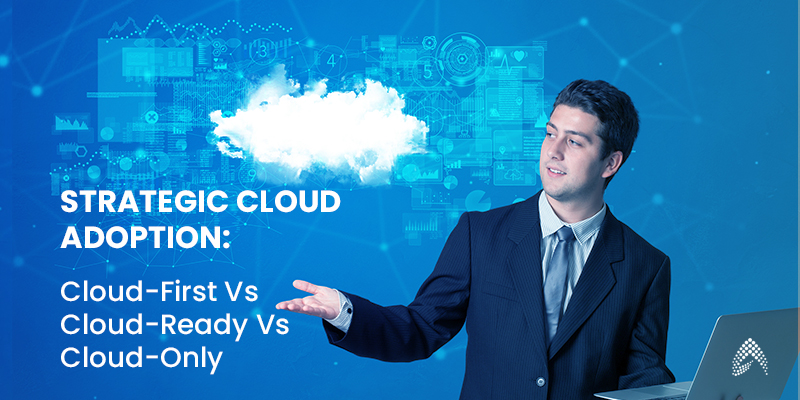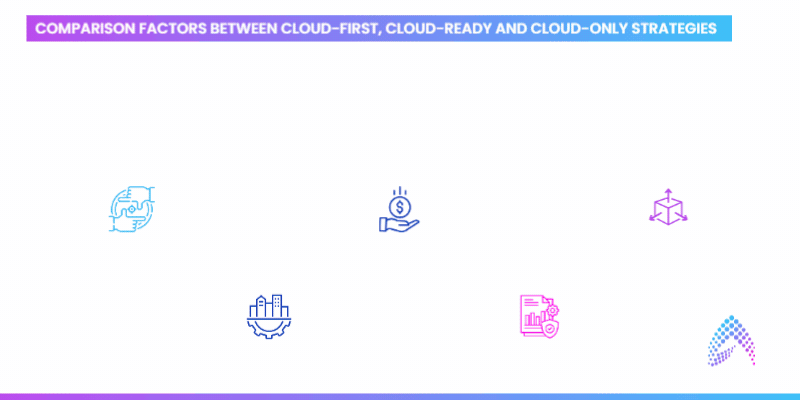Comparing Cloud Adoption Strategies: Cloud-First vs Cloud-Ready vs Cloud-only

Introduction
Starting a business used to require a large investment in servers and software. Now, cloud solutions provide a more cost-effective way to get started.
Amidst the rush to migrate to the cloud, it’s important to carefully consider whether a cloud-first, cloud-ready, or cloud-only approach is best for your business. This blog will help you decide which strategy will give your business the best competitive edge.
Cloud-First Strategy
A cloud-first strategy prioritizes cloud computing services to reduce the burden of traditional IT solutions. This doesn’t necessarily exclude users of on-premises solutions but establishes the cloud as the preferred option. When a business decision or a new IT requirement arises, organizations evaluate and prioritize cloud technology adoption.
Example:
A large retail company may opt for a cloud-first strategy by deploying its new e-commerce platform on a cloud service, rather than physical servers. This approach allows for scalability to handle peak shopping periods like Black Friday without requiring significant upfront investments in hardware.
Cloud-Ready Strategy
Cloud-ready refers to preparing applications and data infrastructure to be easily migrated to the cloud environment, ensuring systems, platforms, and processes are compatible with cloud environments. This approach ensures that the transition to the cloud can occur smoothly and without significant redesign or interruption.
Example:
Imagine your business currently operates on an outdated ERP system. By embracing a cloud-ready strategy like Re-architecting or Rehosting, you can adapt or overhaul this system to align with cloud technologies. This strategic move guarantees a seamless transition when the time comes to migrate.
Learn more about the 6 Rs of cloud application migration strategies.
Cloud-Only Strategy
Modern organizations like startups, rely on cloud-only strategies to optimize their investment budgets and enhance productivity. It involves using cloud services, including private, public, hybrid, or multi-clouds for all computing and storage needs, avoiding investment in physical data centers or servers.
A cloud-only strategy is perfect for businesses that are starting fresh without legacy systems.
Example:
Imagine you’re starting a business. By embracing a cloud-first approach right from scratch, you can harness the full power of the cloud for unlimited scalability and cutting-edge innovation without being weighed down by traditional on-prem IT systems.
Cloud-native application development for customer-centricity
Download our whitepaper to learn more about how cloud-native application development guarantees scalability and success in the future.
Comparison of Cloud Strategies: Cloud-First vs. Cloud-Ready vs. Cloud-Only

Imagine you’re starting a business. By embracing a cloud-first approach right from scratch, you can harness the full power of the cloud for unlimited scalability and cutting-edge innovation without being weighed down by traditional on-prem IT systems.
1. Application Focus
Cloud-First: This strategy prioritizes cloud deployment for all new applications and services. Existing on-premises applications might eventually be migrated, but the primary focus would be building cloud-native applications to take advantage of scalability, flexibility, and resilience.
Cloud-Ready: Here, cloud migration starts with application assessment and prioritization. Migration is usually executed in stages. Critical applications that will benefit most from cloud features are moved first.
Cloud-Only: By moving all applications to the cloud, companies can significantly reduce or eliminate their physical IT infrastructure. This reduces capital expenditures and ongoing maintenance costs and simplifies IT management.
2. Existing Infrastructure
Cloud-First: Existing infrastructure might be maintained for critical applications like data management to ensure privacy and security. However, the focus leans towards minimizing on-premises resources in the future.
Cloud-Ready: Enterprises evaluate their application portfolios to see if they need to be retired or modernized. Infrastructure modernization through Re-architecture and Rehost enables businesses to meet their strategic goals and fast-changing business requirements.
Cloud-only: With a cloud-only strategy, businesses can leverage the full spectrum of cloud services, including IaaS, PaaS, and SaaS, to enhance agility and scalability. This seamless integration supports faster innovation cycles and global scalability and rapidly adapts to market changes or customer demands.
3. Cost Considerations
Cloud-First: These strategies may involve upfront costs for migrating existing applications, but can lead to long-term cost savings through pay-as-you-go models and resource optimization offered by cloud providers.
Cloud-Ready: The cost here can be variable, influenced by the nature and number of applications to be migrated. Some legacy applications may require significant refactoring or even complete redevelopment, which can be resource-intensive and costly.
Cloud-Only: Since you can deploy and access applications on the cloud, there is a potential cost reduction in hardware maintenance and IT staff dedicated to on-premises systems. However, you must pay attention to cloud subscription fees and ongoing cloud resource optimization.
4. Security and Compliance
Cloud-First: This strategy leverages the advanced security measures provided by cloud vendors, including robust data encryption, automated security patches, and sophisticated threat detection systems.
Cloud-Ready: Security is the major concern during and after migrating to the cloud. Organizations consider Refactoring or Rearchitecting methods to ensure new code is compatible with modern cloud architects and meets security standards.
Cloud-Only: This cloud adoption strategy trusts cloud providers to handle all aspects of IT operations, including security and compliance. Cloud-only companies benefit from the full spectrum of security tools and compliance frameworks, including continuous compliance monitoring, real-time security analytics, and compliance-ready environments that meet global standards.
5. Scalability and Agility
Cloud-First: A cloud-first strategy enables organizations to scale resources quickly as needed. By prioritizing cloud solutions, companies can adopt cloud providers’ latest technologies and innovations, such as AI capabilities, advanced analytics, and cutting-edge development tools.
Cloud-Ready: In the cloud-ready strategy, organizations plan their migration in phases, which can be strategically aligned with business cycles and investment capabilities. This readiness allows organizations to move parts of their operations to the cloud per their growing demands.
Cloud-Only: Businesses operating with a cloud-only model can reap maximum benefits in terms of scalability and agility. They can quickly pivot or adapt their technology stack in response to new opportunities or challenges, leveraging the full spectrum of cloud services. Resources can be increased or decreased in real-time without worrying about physical infrastructure limitations.
Choosing the Right Path:
The ideal cloud strategy depends on your unique business needs, existing infrastructure, budget considerations, and security requirements. Cloud-first offers a future-proof approach, cloud-ready provides flexibility, and cloud-only delivers unparalleled scalability. Evaluating these factors across the five key aspects discussed will guide you toward the most fitting cloud strategy for your organization’s journey.
Do you still need to decide which cloud strategy helps you the most? Get in touch with our cloud expert team to have a free brainstorming session.

Director – Global Delivery




